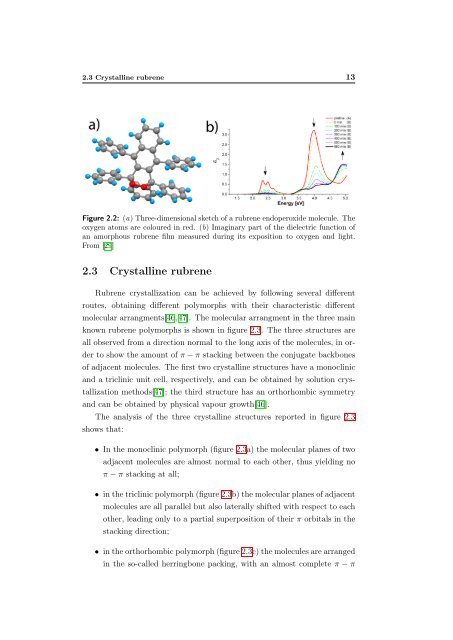Growth and physical properties of crystalline rubrene - BOA Bicocca ...
Growth and physical properties of crystalline rubrene - BOA Bicocca ...
Growth and physical properties of crystalline rubrene - BOA Bicocca ...
You also want an ePaper? Increase the reach of your titles
YUMPU automatically turns print PDFs into web optimized ePapers that Google loves.
2.3 Crystalline <strong>rubrene</strong> 13<br />
Figure 2.2: (a) Three-dimensional sketch <strong>of</strong> a <strong>rubrene</strong> endoperoxide molecule. The<br />
oxygen atoms are coloured in red. (b) Imaginary part <strong>of</strong> the dielectric function <strong>of</strong><br />
an amorphous <strong>rubrene</strong> film measured during its exposition to oxygen <strong>and</strong> light.<br />
From [29]<br />
2.3 Crystalline <strong>rubrene</strong><br />
Rubrene crystallization can be achieved by following several different<br />
routes, obtaining different polymorphs with their characteristic different<br />
molecular arrangments[46,47]. The molecular arrangment in the three main<br />
known <strong>rubrene</strong> polymorphs is shown in figure 2.3. The three structures are<br />
all observed from a direction normal to the long axis <strong>of</strong> the molecules, in or-<br />
der to show the amount <strong>of</strong> π − π stacking between the conjugate backbones<br />
<strong>of</strong> adjacent molecules. The first two <strong>crystalline</strong> structures have a monoclinic<br />
<strong>and</strong> a triclinic unit cell, respectively, <strong>and</strong> can be obtained by solution crys-<br />
tallization methods[47]; the third structure has an orthorhombic symmetry<br />
<strong>and</strong> can be obtained by <strong>physical</strong> vapour growth[46].<br />
The analysis <strong>of</strong> the three <strong>crystalline</strong> structures reported in figure 2.3<br />
shows that:<br />
• In the monoclinic polymorph (figure 2.3a) the molecular planes <strong>of</strong> two<br />
adjacent molecules are almost normal to each other, thus yielding no<br />
π − π stacking at all;<br />
• in the triclinic polymorph (figure 2.3b) the molecular planes <strong>of</strong> adjacent<br />
molecules are all parallel but also laterally shifted with respect to each<br />
other, leading only to a partial superposition <strong>of</strong> their π orbitals in the<br />
stacking direction;<br />
• in the orthorhombic polymorph (figure 2.3c) the molecules are arranged<br />
in the so-called herringbone packing, with an almost complete π − π

















